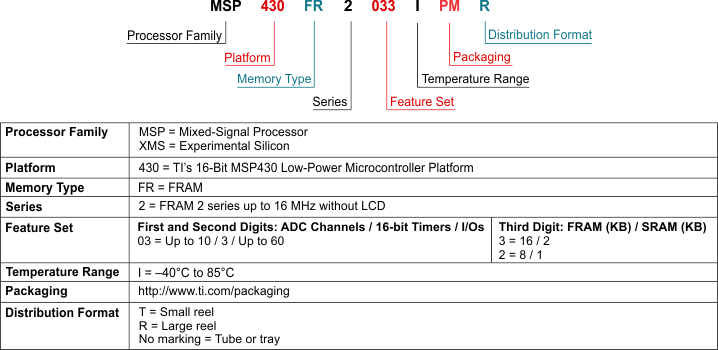JAJSG12E October 2014 – December 2019 MSP430FR2032 , MSP430FR2033
PRODUCTION DATA.
- 1デバイスの概要
- 2改訂履歴
- 3Device Comparison
- 4Terminal Configuration and Functions
-
5Specifications
- 5.1 Absolute Maximum Ratings
- 5.2 ESD Ratings
- 5.3 Recommended Operating Conditions
- 5.4 Active Mode Supply Current Into VCC Excluding External Current
- 5.5 Active Mode Supply Current Per MHz
- 5.6 Low-Power Mode LPM0 Supply Currents Into VCC Excluding External Current
- 5.7 Low-Power Mode LPM3 and LPM4 Supply Currents (Into VCC) Excluding External Current
- 5.8 Low-Power Mode LPMx.5 Supply Currents (Into VCC) Excluding External Current
- 5.9 Typical Characteristics, Low-Power Mode Supply Currents
- 5.10 Typical Characteristics - Current Consumption Per Module
- 5.11 Thermal Characteristics
- 5.12
Timing and Switching Characteristics
- 5.12.1 Power Supply Sequencing
- 5.12.2 Reset Timing
- 5.12.3 Clock Specifications
- 5.12.4 Digital I/Os
- 5.12.5 Timer_A
- 5.12.6
eUSCI
- Table 5-11 eUSCI (UART Mode) Recommended Operating Conditions
- Table 5-12 eUSCI (UART Mode) Switching Characteristics
- Table 5-13 eUSCI (SPI Master Mode) Recommended Operating Conditions
- Table 5-14 eUSCI (SPI Master Mode) Switching Characteristics
- Table 5-15 eUSCI (SPI Slave Mode) Switching Characteristics
- Table 5-16 eUSCI (I2C Mode) Switching Characteristics
- 5.12.7 ADC
- 5.12.8 FRAM
- 5.12.9 Emulation and Debug
-
6Detailed Description
- 6.1 CPU
- 6.2 Operating Modes
- 6.3 Interrupt Vector Addresses
- 6.4 Bootloader (BSL)
- 6.5 JTAG Standard Interface
- 6.6 Spy-Bi-Wire Interface (SBW)
- 6.7 FRAM
- 6.8 Memory Protection
- 6.9
Peripherals
- 6.9.1 Power Management Module (PMM) and On-chip Reference Voltages
- 6.9.2 Clock System (CS) and Clock Distribution
- 6.9.3 General-Purpose Input/Output Port (I/O)
- 6.9.4 Watchdog Timer (WDT)
- 6.9.5 System Module (SYS)
- 6.9.6 Cyclic Redundancy Check (CRC)
- 6.9.7 Enhanced Universal Serial Communication Interface (eUSCI_A0, eUSCI_B0)
- 6.9.8 Timers (Timer0_A3, Timer1_A3)
- 6.9.9 Real-Time Clock (RTC) Counter
- 6.9.10 10-Bit Analog Digital Converter (ADC)
- 6.9.11 Embedded Emulation Module (EEM)
- 6.9.12
Input/Output Diagrams
- 6.9.12.1 Port P1 Input/Output With Schmitt Trigger
- 6.9.12.2 Port P2 Input/Output With Schmitt Trigger
- 6.9.12.3 Port P3 Input/Output With Schmitt Trigger
- 6.9.12.4 Port P4.0 Input/Output With Schmitt Trigger
- 6.9.12.5 Port P4.1 and P4.2 Input/Output With Schmitt Trigger
- 6.9.12.6 Port 4.3, P4.4, P4.5, P4.6, and P4.7 Input/Output With Schmitt Trigger
- 6.9.12.7 Port P5.0, P5.1, P5.2, and P5.3 Input/Output With Schmitt Trigger
- 6.9.12.8 Port P5.4, P5.5, P5.6, and P5.7 Input/Output With Schmitt Trigger
- 6.9.12.9 Port P6.0, P6.1, P6.2, and P6.3 Input/Output With Schmitt Trigger
- 6.9.12.10 Port P6.4, P6.5, P6.6, and P6.7 Input/Output With Schmitt Trigger
- 6.9.12.11 Port P7.0, P7.1, P7.2, and P7.3 Input/Output With Schmitt Trigger
- 6.9.12.12 Port P7.4, P7.5, P7.6, and P7.7 Input/Output With Schmitt Trigger
- 6.9.12.13 Port P8.0 and P8.1 Input/Output With Schmitt Trigger
- 6.9.12.14 Port P8.2 and P8.3 Input/Output With Schmitt Trigger
- 6.10 Device Descriptors (TLV)
- 6.11 Memory
- 6.12 Identification
- 7Applications, Implementation, and Layout
- 8デバイスおよびドキュメントのサポート
- 9メカニカル、パッケージ、および注文情報
パッケージ・オプション
メカニカル・データ(パッケージ|ピン)
サーマルパッド・メカニカル・データ
発注情報
8.2 デバイスの項目表記
製品開発サイクルの段階を示すために、TIではMSP MCUデバイスのすべての型番に接頭辞が割り当てられています。MSP MCU商用ファミリの各番号には、MSP、XMSのいずれかの接頭辞があります。これらの接頭辞は、製品開発の進展段階を表します。段階には、エンジニアリング・プロトタイプ(XMS)から、完全認定済みの量産デバイス(MSP)までがあります。
XMS - 実験段階のデバイスで、最終的なデバイスの電気的仕様を表しているとは限りません。
MSP - 完全に認定済みの量産版デバイスです。
XMSデバイスは、次の免責事項付きで出荷されます。
「開発中の製品は、社内での評価用です。」
MSPデバイスの特性は完全に明確化されており、デバイスの品質と信頼性が十分に示されています。TIの標準保証が適用されます。
プロトタイプ・デバイス(XMS)は標準の量産デバイスよりも故障率が高いことが予想されます。これらのデバイスは、予測される最終使用時の故障率が未定義であるため、TIはそれらのデバイスを量産システムで使用しないよう推奨しています。認定された量産デバイスのみを使用する必要があります。
TIデバイスの項目表記には、デバイス・ファミリ名の接尾辞も含まれます。この接尾辞は、温度範囲、パッケージ・タイプ、配布形式を示しています。デバイス名の各部の読み方をに示します。
 Figure 8-1 デバイスの項目表記
Figure 8-1 デバイスの項目表記